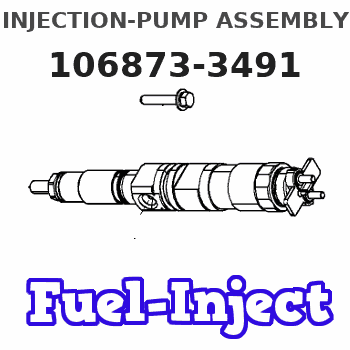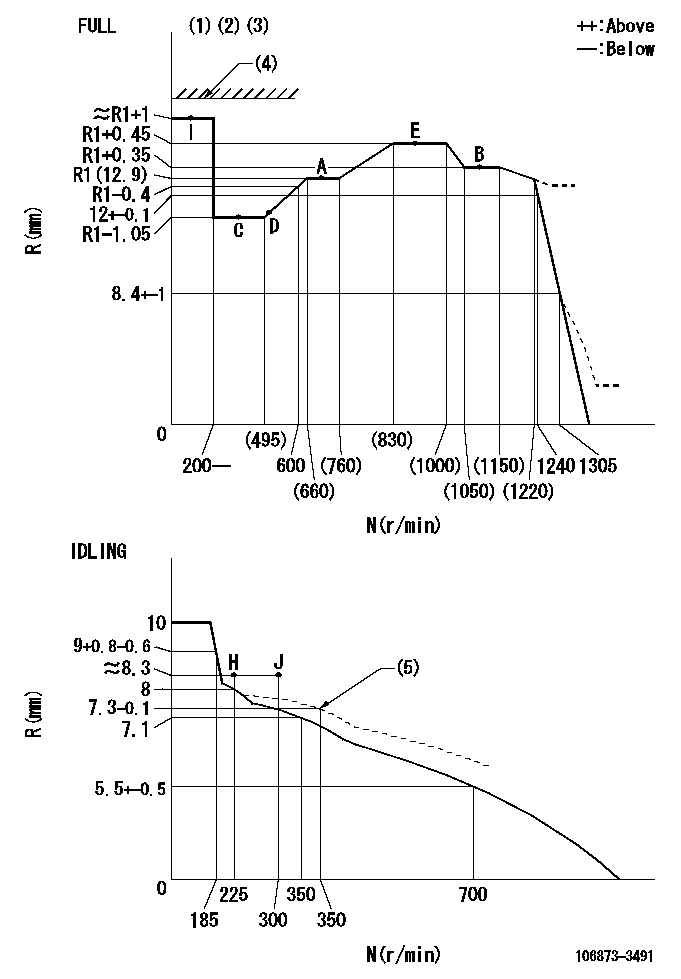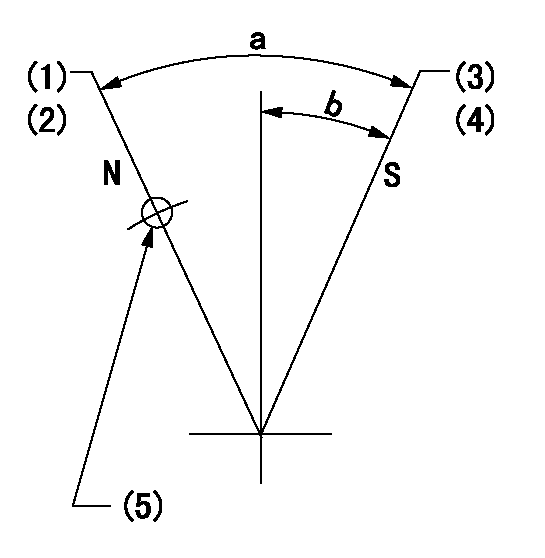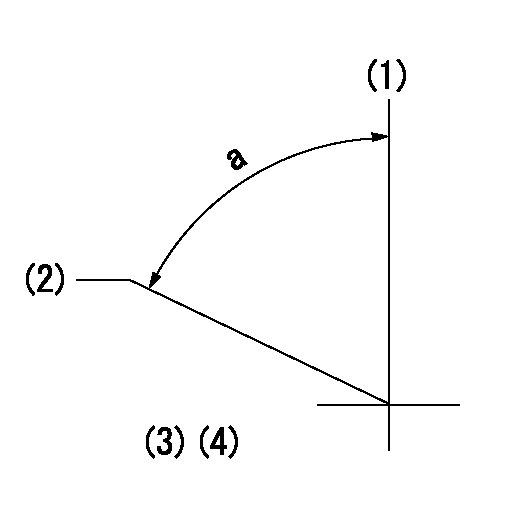Information injection-pump assembly
ZEXEL
106873-3491
1068733491
HINO
220009261B
220009261b

Rating:
Service parts 106873-3491 INJECTION-PUMP ASSEMBLY:
1.
_
7.
COUPLING PLATE
8.
_
9.
_
11.
Nozzle and Holder
23600-2750A
12.
Open Pre:MPa(Kqf/cm2)
14.7{150}/21.6{220}
14.
NOZZLE
Include in #1:
106873-3491
as INJECTION-PUMP ASSEMBLY
Cross reference number
ZEXEL
106873-3491
1068733491
HINO
220009261B
220009261b
Zexel num
Bosch num
Firm num
Name
Calibration Data:
Adjustment conditions
Test oil
1404 Test oil ISO4113 or {SAEJ967d}
1404 Test oil ISO4113 or {SAEJ967d}
Test oil temperature
degC
40
40
45
Nozzle and nozzle holder
105780-8250
Bosch type code
1 688 901 101
Nozzle
105780-0120
Bosch type code
1 688 901 990
Nozzle holder
105780-2190
Opening pressure
MPa
20.7
Opening pressure
kgf/cm2
211
Injection pipe
Outer diameter - inner diameter - length (mm) mm 8-3-600
Outer diameter - inner diameter - length (mm) mm 8-3-600
Overflow valve
134424-4120
Overflow valve opening pressure
kPa
255
221
289
Overflow valve opening pressure
kgf/cm2
2.6
2.25
2.95
Tester oil delivery pressure
kPa
255
255
255
Tester oil delivery pressure
kgf/cm2
2.6
2.6
2.6
Direction of rotation (viewed from drive side)
Right R
Right R
Injection timing adjustment
Direction of rotation (viewed from drive side)
Right R
Right R
Injection order
1-8-6-2-
7-5-4-3
Pre-stroke
mm
4
3.94
4
Beginning of injection position
Drive side NO.1
Drive side NO.1
Difference between angles 1
Cal 1-8 deg. 45 44.75 45.25
Cal 1-8 deg. 45 44.75 45.25
Difference between angles 2
Cal 1-6 deg. 90 89.75 90.25
Cal 1-6 deg. 90 89.75 90.25
Difference between angles 3
Cyl.1-2 deg. 135 134.75 135.25
Cyl.1-2 deg. 135 134.75 135.25
Difference between angles 4
Cal 1-7 deg. 180 179.75 180.25
Cal 1-7 deg. 180 179.75 180.25
Difference between angles 5
Cal 1-5 deg. 225 224.75 225.25
Cal 1-5 deg. 225 224.75 225.25
Difference between angles 6
Cal 1-4 deg. 270 269.75 270.25
Cal 1-4 deg. 270 269.75 270.25
Difference between angles 7
Cal 1-3 deg. 315 314.75 315.25
Cal 1-3 deg. 315 314.75 315.25
Injection quantity adjustment
Adjusting point
-
Rack position
12.9
Pump speed
r/min
700
700
700
Average injection quantity
mm3/st.
140.5
137.5
143.5
Max. variation between cylinders
%
0
-2
2
Basic
*
Fixing the rack
*
Standard for adjustment of the maximum variation between cylinders
*
Injection quantity adjustment_02
Adjusting point
Z
Rack position
8.3+-0.5
Pump speed
r/min
420
420
420
Average injection quantity
mm3/st.
15.9
12.9
18.9
Max. variation between cylinders
%
0
-15
15
Fixing the rack
*
Standard for adjustment of the maximum variation between cylinders
*
Injection quantity adjustment_03
Adjusting point
A
Rack position
R1(12.9)
Pump speed
r/min
700
700
700
Average injection quantity
mm3/st.
140.5
138.5
142.5
Basic
*
Fixing the lever
*
Injection quantity adjustment_04
Adjusting point
B
Rack position
R1+0.35
Pump speed
r/min
1100
1100
1100
Average injection quantity
mm3/st.
127
121
133
Fixing the lever
*
Injection quantity adjustment_05
Adjusting point
C
Rack position
R1-1.05
Pump speed
r/min
330
330
330
Average injection quantity
mm3/st.
138
128
148
Fixing the lever
*
Timer adjustment
Pump speed
r/min
710--
Advance angle
deg.
0
0
0
Load
2/5
Remarks
Start
Start
Timer adjustment_02
Pump speed
r/min
660
Advance angle
deg.
0.3
Load
2/5
Timer adjustment_03
Pump speed
r/min
(760)
Advance angle
deg.
2
1.7
2.3
Load
5/5
Remarks
Measure the actual speed.
Measure the actual speed.
Timer adjustment_04
Pump speed
r/min
900+50
Advance angle
deg.
2
1.7
2.3
Load
4/5
Timer adjustment_05
Pump speed
r/min
1100-50
Advance angle
deg.
5.75
5.45
6.05
Load
5/5
Remarks
Finish
Finish
Test data Ex:
Governor adjustment

N:Pump speed
R:Rack position (mm)
(1)Torque cam stamping: T1
(2)Tolerance for racks not indicated: +-0.05mm.
(3)Set stop lever before governor adjustment. [When setting stop lever after governor adjustment, confirm that point I (Ra) can be obtained at full setting.]
(4)Stop lever's normal position setting: equivalent to RA
(5)Damper spring setting
----------
T1=AD70 Ra=R1+1mm RA=17.5mm
----------
----------
T1=AD70 Ra=R1+1mm RA=17.5mm
----------
Speed control lever angle

F:Full speed
I:Idle
(1)Use the hole at R = aa
(2)Stopper bolt set position 'H'
----------
aa=94mm
----------
a=15deg+-5deg b=42.5deg+-3deg
----------
aa=94mm
----------
a=15deg+-5deg b=42.5deg+-3deg
Stop lever angle

N:Pump normal
S:Stop the pump.
(1)Rack position = aa
(2)Set the stopper screw. (After setting, apply red paint.)
(3)Rack position = bb (speed = cc)
(4)Set the stopper screw. (After setting, apply red paint.)
(5)Use the hole above R = dd
----------
aa=(17.5)mm bb=1.5+-0.3mm cc=0r/min dd=35mm
----------
a=35deg+-5deg b=15deg+-5deg
----------
aa=(17.5)mm bb=1.5+-0.3mm cc=0r/min dd=35mm
----------
a=35deg+-5deg b=15deg+-5deg
Timing setting

(1)Pump vertical direction
(2)Coupling's key groove position at No 1 cylinder's beginning of injection
(3)-
(4)-
----------
----------
a=(80deg)
----------
----------
a=(80deg)
Information:
Fuel Injection Nozzles
Test/Clean/Replace
The engine will be damaged if a defective fuel injection nozzle is used because of the shape of fuel (spray pattern) that comes out of the nozzles will not be correct.
Fuel injection nozzles are subject to tip wear as a result of fuel contamination. This damage can cause an increase in fuel consumption, the engine to emit black smoke, misfire or run rough. Inspect, test and replace if necessary.Whenever the engine performs in such a manner that a fuel injection nozzle is suspected of causing irregular running, smoking or knocking, each fuel injection nozzle must be isolated, one at a time, to determine the malfunctioning nozzle. Special tooling is required to remove fuel injection nozzles. Refer to the Service Manual or contact your Caterpillar dealer for fuel injection nozzle testing and cleaning procedures.Turbocharger
Periodic inspection and cleaning is recommended for the turbocharger compressor housing (inlet side) and the aftercooler core. Since the crankcase fumes are ingested through the inlet air system, oil and combustion by-products may collect in these two areas.This buildup, over time, can contribute to loss of engine power, increased black smoke, and overall loss of engine efficiency. This buildup is only a possible contributor to these conditions.Operating the engine until the turbocharger fails can severely damage the turbocharger's compressor wheel and/or the engine. Damage to the turbocharger compressor wheel could allow parts from the compressor wheel to enter the engine cylinder, causing additional damage to the piston, valve, and cylinder head.
Turbocharger bearing failures can cause large quantities of oil to enter the air inlet and exhaust systems. Loss of engine lubricant can result in serious engine damage.When a turbocharger bearing failure is accompanied by a significant engine performance loss (exhaust smoke or engine speed up at no load), DO NOT continue engine operation until the turbocharger is repaired or replaced.
Minor leakage of a turbocharger housing under extended low idle operation will not cause problems as long as no turbocharger bearing failure occurred.Inspect for Proper Operation
Turbocharger components require precision clearances and balancing due to operation at high rotational speeds. Severe Service Applications can accelerate component wear and may suggest the need to Inspect/Repair/Replace the cartridge at reduced intervals to ensure maximum reliability and retention of full core value.The following conditions can indicate severe service operation.* Frequent high altitude operation above 5,000 ft (1525 m).* Arctic operation (regular cold starts at temperatures below 0°C [32°F]).* Extending lubrication and inlet air system maintenance intervals. 1. Remove the exhaust outlet piping (1) and inlet piping (2) from the turbocharger. Visually check for oil leaks.2. Turn the compressor wheel and turbine wheel by hand. The assembly should turn freely. Inspect the compressor wheel and turbine wheel for contact with the turbocharger housing. There should NOT be any visible signs of contact between the turbine or compressor wheel and the turbocharger housing. If there is any indication of contact between the rotating wheel(s) and the housing, the turbocharger should be reconditioned or replaced.3. Use a dial indicator to check end
Test/Clean/Replace
The engine will be damaged if a defective fuel injection nozzle is used because of the shape of fuel (spray pattern) that comes out of the nozzles will not be correct.
Fuel injection nozzles are subject to tip wear as a result of fuel contamination. This damage can cause an increase in fuel consumption, the engine to emit black smoke, misfire or run rough. Inspect, test and replace if necessary.Whenever the engine performs in such a manner that a fuel injection nozzle is suspected of causing irregular running, smoking or knocking, each fuel injection nozzle must be isolated, one at a time, to determine the malfunctioning nozzle. Special tooling is required to remove fuel injection nozzles. Refer to the Service Manual or contact your Caterpillar dealer for fuel injection nozzle testing and cleaning procedures.Turbocharger
Periodic inspection and cleaning is recommended for the turbocharger compressor housing (inlet side) and the aftercooler core. Since the crankcase fumes are ingested through the inlet air system, oil and combustion by-products may collect in these two areas.This buildup, over time, can contribute to loss of engine power, increased black smoke, and overall loss of engine efficiency. This buildup is only a possible contributor to these conditions.Operating the engine until the turbocharger fails can severely damage the turbocharger's compressor wheel and/or the engine. Damage to the turbocharger compressor wheel could allow parts from the compressor wheel to enter the engine cylinder, causing additional damage to the piston, valve, and cylinder head.
Turbocharger bearing failures can cause large quantities of oil to enter the air inlet and exhaust systems. Loss of engine lubricant can result in serious engine damage.When a turbocharger bearing failure is accompanied by a significant engine performance loss (exhaust smoke or engine speed up at no load), DO NOT continue engine operation until the turbocharger is repaired or replaced.
Minor leakage of a turbocharger housing under extended low idle operation will not cause problems as long as no turbocharger bearing failure occurred.Inspect for Proper Operation
Turbocharger components require precision clearances and balancing due to operation at high rotational speeds. Severe Service Applications can accelerate component wear and may suggest the need to Inspect/Repair/Replace the cartridge at reduced intervals to ensure maximum reliability and retention of full core value.The following conditions can indicate severe service operation.* Frequent high altitude operation above 5,000 ft (1525 m).* Arctic operation (regular cold starts at temperatures below 0°C [32°F]).* Extending lubrication and inlet air system maintenance intervals. 1. Remove the exhaust outlet piping (1) and inlet piping (2) from the turbocharger. Visually check for oil leaks.2. Turn the compressor wheel and turbine wheel by hand. The assembly should turn freely. Inspect the compressor wheel and turbine wheel for contact with the turbocharger housing. There should NOT be any visible signs of contact between the turbine or compressor wheel and the turbocharger housing. If there is any indication of contact between the rotating wheel(s) and the housing, the turbocharger should be reconditioned or replaced.3. Use a dial indicator to check end